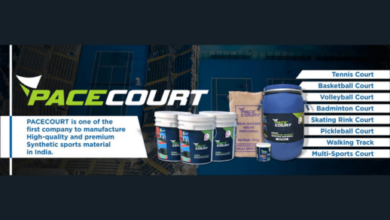Choosing the Right Flooring for Your Badminton Court: What You Need to Know

Badminton is a fast-paced and exhilarating sport that demands high performance from both players and the court. Whether you’re building a court at home, in a recreational facility, or as part of a professional setup, one of the most crucial elements for ensuring a smooth and safe game is the flooring. Selecting the right badminton court flooring not only impacts the aesthetic appeal but also enhances player performance and minimizes injury risks. Here’s everything you need to know when choosing the perfect flooring for your badminton court.
Why Does the Right Badminton Court Flooring Matters?
Badminton involves rapid lateral movements, quick footwork, and precise jumps. The surface of the court directly influences the game’s speed, the players’ comfort, and most importantly, their safety. The wrong flooring can lead to injuries, reduce court durability, and create an inconsistent playing surface. Choosing the right flooring material ensures proper cushioning, grip, and bounce, providing a court that supports professional play while preventing long-term injuries.
Key Factors to Consider when choosing Badminton Court
When it comes to selecting flooring for a badminton court, here are the most important factors to keep in mind:
1. Type of Court (Indoor vs. Outdoor)
Badminton courts can be set up both indoors and outdoors, and the type of court plays a significant role in the choice of flooring. Indoor courts tend to have more controlled environments, with consistent temperature and humidity levels, making it easier to maintain the quality of the flooring. Outdoor courts, on the other hand, need to withstand weather conditions like rain, wind, and heat. For outdoor courts, it’s essential to choose durable, weather-resistant flooring that can handle these challenges.
2. Durability and Maintenance
Badminton courts are subject to heavy foot traffic, frequent use, and aggressive movements, so durability is a key consideration. High-quality flooring will not only endure wear and tear but also retain its grip and appearance over time. Materials like polyurethane, rubber, and wooden sports flooring are designed to last and withstand the intensity of badminton games.
Maintenance is another aspect of flooring longevity. Some materials, like wooden floors, require more upkeep to maintain their appearance and performance, while synthetic surfaces are easier to clean and maintain. Depending on the use and budget, you can choose between low-maintenance options and more premium, higher-maintenance materials.
3. Cushioning and Shock Absorption
One of the most important aspects of badminton flooring is its ability to absorb shock. Badminton requires fast-paced footwork and jumping, which puts stress on joints and muscles. The flooring should provide adequate cushioning to reduce the impact on the knees and ankles, especially during high-intensity games. Wooden floors, such as maple or birch, are often favored for their shock-absorbing properties. PVC vinyl flooring and rubber flooring also offer excellent cushioning and comfort for players.
4. Grip and Traction
Grip is essential for players to move swiftly and safely. Flooring should provide traction to prevent slipping, especially during fast lateral movements. Polyurethane flooring, for example, is known for its excellent grip and stability. Materials like rubber or sports vinyl are also great for providing the right amount of friction between the players’ footwear and the surface, ensuring they can pivot, jump, and land with confidence.
5. Surface Texture and Bounce
The bounce of the shuttlecock is another vital factor in determining the right flooring for your badminton court. A consistent and predictable bounce is crucial for a fair game. Wooden floors tend to offer a more natural bounce, mimicking professional indoor badminton courts. However, synthetic floors like PVC or rubber also maintain an even bounce and can be more resilient over time.
Choosing a flooring material with a consistent surface texture will ensure that the shuttlecock bounces in a uniform manner, enhancing the gameplay experience for both amateurs and professionals alike.
6. Cost and Budget
Badminton court flooring options come in a wide range of prices, depending on the material and quality. Wooden flooring is often the most expensive, but it offers the highest quality for indoor professional courts. Synthetic options like PVC vinyl, sports tiles, or rubber flooring are more affordable and can still provide excellent performance and durability for both recreational and professional play.
When setting a budget, also factor in installation costs and maintenance requirements. While some options might have higher upfront costs, they could save you money in the long run due to lower maintenance.
Popular Flooring Materials for Badminton Courts
Here are some popular sport flooring materials used in badminton courts:
1. Wooden Flooring
Wooden flooring, particularly maple or birch, is often considered the gold standard for indoor badminton courts. Known for its durability, excellent shock absorption, and bounce consistency, wooden floors are commonly used in professional tournaments. However, they require periodic maintenance and can be more expensive to install.
2. PVC Vinyl Flooring
PVC vinyl is a versatile and cost-effective option for both indoor and outdoor badminton courts. It is available in interlocking tiles or as a continuous roll, offering easy installation. PVC vinyl is durable, easy to maintain, and provides excellent traction and cushioning.
3. Rubber Flooring
Rubber flooring offers durability, shock absorption, and slip resistance, making it a popular choice for both indoor and outdoor courts. It can handle intense foot traffic and is resistant to wear and tear. Rubber flooring is also low-maintenance and provides a safe playing surface for players of all levels.
4. Interlocking Sports Tiles
Sports tiles are made of rubber or PVC and come in interlocking panels that make installation quick and easy. These tiles are perfect for temporary setups, gyms, or multi-purpose courts. They offer cushioning, grip, and shock absorption and are highly customizable in terms of design.
Conclusion
Choosing the right flooring for your badminton court is a crucial step in ensuring a safe, durable, and high-performing space for players. Whether you are designing a professional indoor court or setting up a recreational outdoor court, the flooring material you select should offer the perfect balance of durability, cushioning, grip, and bounce. Always consider factors like the court’s usage, your budget, and maintenance requirements when making your decision. With the right flooring, your badminton court will provide an exceptional playing experience for years to come.

